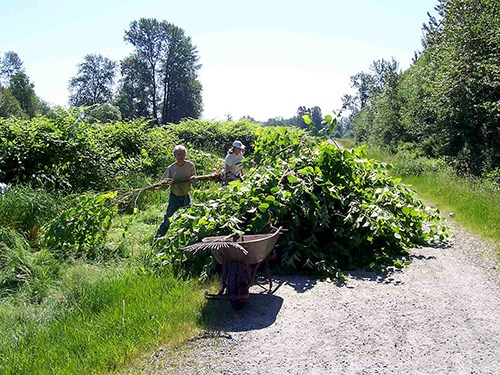One of the inadvertent consequences of human settlement is that we have often introduced new plants to areas where they have never grown.
In the early days of colonization, people sought to establish plants familiar to them. Thus, the first Scottish settlers on Vancouver Island planted broom and gorse to remind them of their homeland. But these plants were ideally suited to conditions on the west coast and soon spread throughout Vancouver Island and beyond. Today, these plants and several others are on an unwanted list of invasive species which have proven to be particularly troublesome invaders that usurp our natural spaces and diminish their value for wildlife.
Throughout the Lower Mainland teams of volunteers working in partnership with parks staff are now valiantly engaged in a battle to get some of these invasives under control.
Without a doubt, the worst invasive plant is giant hogweed. It contains sap in tiny hairs covering the plant that, after exposure to sunlight, causes severe blistering and scars. Removal of giant hogweed should only be undertaken by trained and properly clothed people.
Most municipalities now provide information on their websites regarding the identification and elimination of invasive plant species. If you think you have identified a patch of giant hogweed, do not attempt to remove it — call your city hall instead.
After giant hogweed, the next most invasive plant of concern is Japanese knotweed. In Great Britain, it has a reputation for growing through — and destroying — roads and concrete foundations.
Because of its remarkable ability to regenerate from only a thin sliver of its rhizome, the removal of contaminated soil has been estimated to cost up to $80,000 per square meter of knotweed.
The rules in Great Britain require an excavation 2 m deep with a radius of 7 m plus placement of a copper membrane to protect the remaining soil.
And then, there is the challenge of dealing with the contaminated soil. In fact, it is the contamination of soil with tiny pieces of knotweed that is likely mainly responsible for its spread. Several years ago, the city of Port Moody established a hedgerow of native plants at the Shoreline Park but the soil brought in for planting had been contaminated with knotweed. In only a few years, knotweed had taken over the site.
Knotweed was first introduced to Great Britain in 1850 from Japan. For many years, it was a favourite of gardeners, with its large leaves and appealing spires of white blossoms that attract a variety of insects. With a growth rate of up to 10 cm a day, it has a propensity to quickly dominate a site.
While some invasive plants can be eliminated by careful hand weeding, knotweed has proven to be a bigger challenge. The proscribed method for its removal in the Lower Mainland is the injection of stems with glyphosate. Often, more than one treatment is required.
In Japan, knotweed grows on volcanic slopes, where it has evolved to survive the occasional eruption and be buried beneath hot ash, where its roots can lie dormant for several years.
For such a monster plant, it is often wise to look at nature for a solution. In Japan, there are known to be 186 insects that feast on Japanese knotweed and, thus, keep it under control. In Great Britain, the search is now on for one of insects that will predate on knotweed but cause no problem to any of the country’s native plants and domestic crops. Five years of research has narrowed the list down to a single candidate, a psyllid (plant louse), which is presently being tested to ensure there will be no unforeseen consequences for other plant species.
Should this approach prove successful, then another careful examination of impacts on native North American species would have to be carried out before the psyllid could be used here. Help may be on the way but it’s going to be very slow in coming.
The challenges of eliminating knotweed have not deterred the Friends of DeBoville Slough. For the past 10 years, this group of intrepid volunteers has been hand-weeding knotweed on the dikes at DeBoville in northeast Coquitlam.
While there were several small patches of knotweed (and some are still there), the first area volunteers tackled in 2005 was a veritable forest of knotweed about 3 m in height covering an area approximately 100 by 7 m on the south dike not far from the trail entrance.
They worked with the city of Coquitlam and the developer Wesbild to remove the knotweed by hand-clipping and wisely insisted the knotweed be taken to the Burnaby incinerator for disposal.
With several weeding events scheduled each year, impressive progress has been made. This area, once thick with knotweed, has now been mostly replaced with a thick mat of reed canary grass, a sod-forming grass that thrives in damp soils. While this grass of low-forage value is also considered to be a somewhat invasive plant, it is actually an appropriate species for dikes as it helps stabilize the soil.
Knotweed is essentially gone from this area, with only occasional sparse shoots reappearing in spring. Keeping it under control now takes little time and allows volunteers to turn their attention to other areas of knotweed infestation at the slough. It is hoped that, at some point, the remaining rhizomes will lose their capacity for re-growth.
––Elaine Golds is a Port Moody environmentalist who is conservation/education chair of the Burke Mountain Naturalists and member of the boards of the Colony Farm Park Association and the Port Moody Ecological Society.



